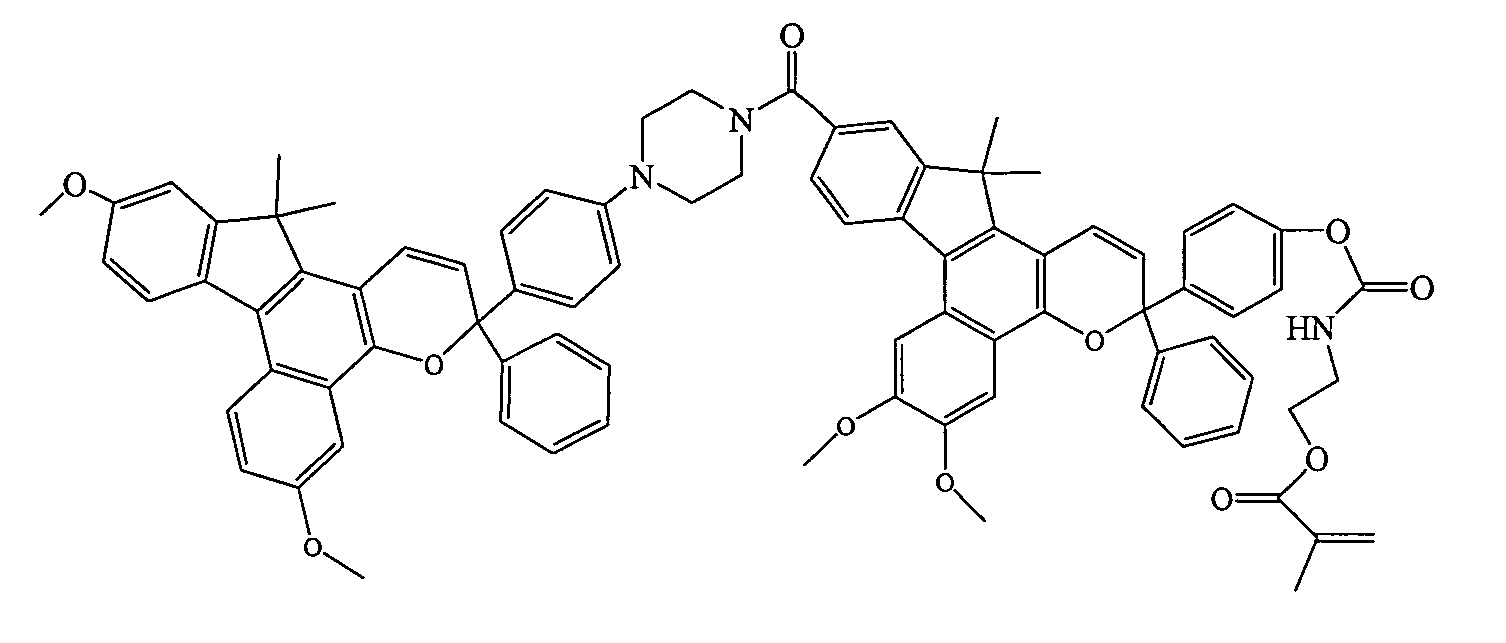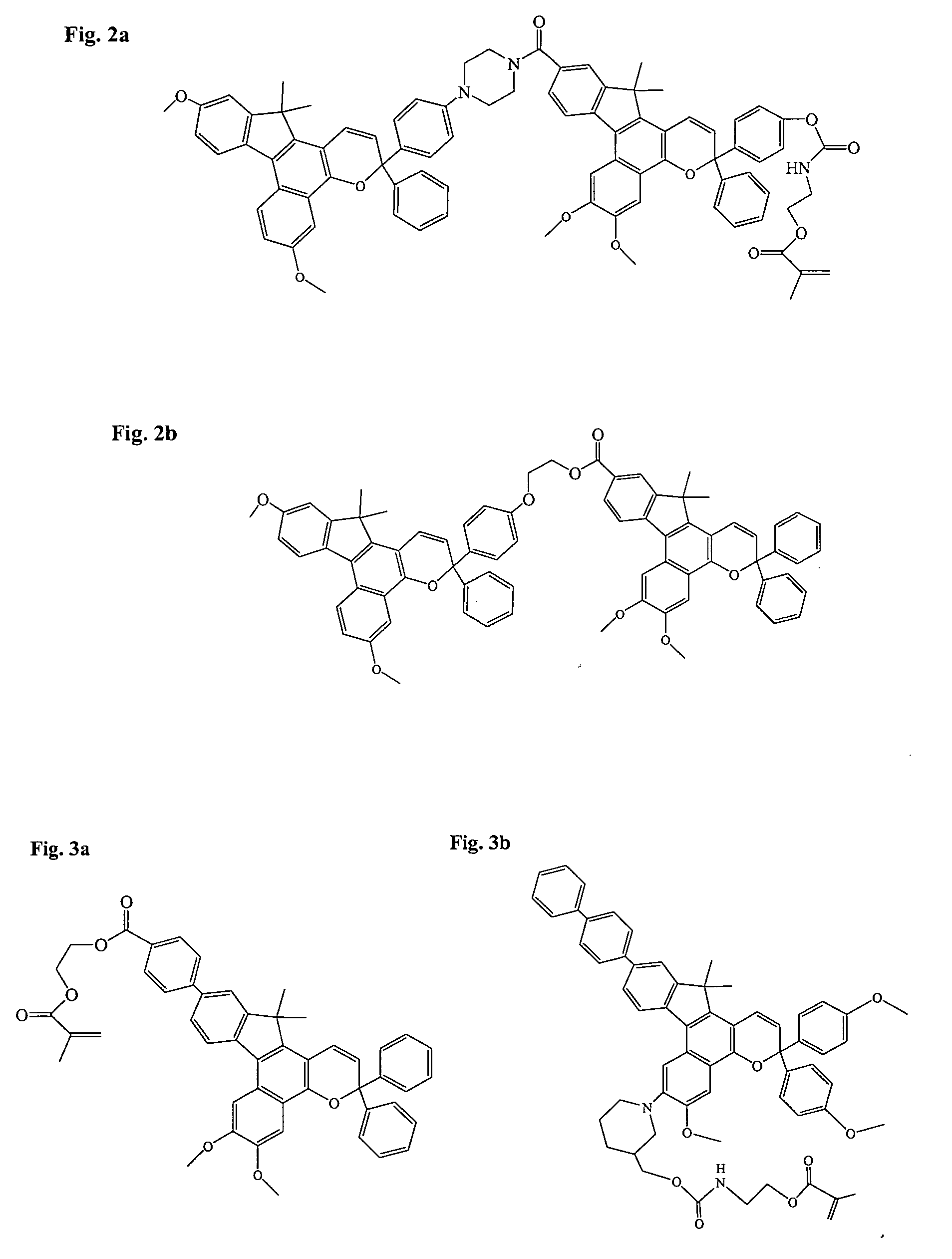Photochromic materials having extended pi-conjugated systems and compositions and articles including the same
a technology of photochromic materials and conjugated systems, applied in the direction of photosensitive materials, instruments, transportation and packaging, etc., can solve the problems of limited amount of photochromic material that can be incorporated into the article, limited amount of photochromic material, and inability to use conventional photochromic materials with a relatively low molar absorption coefficient in such articles
- Summary
- Abstract
- Description
- Claims
- Application Information
AI Technical Summary
Benefits of technology
Problems solved by technology
Method used
Image
Examples
example 1
Step 1
[0148]1,2-Dimethoxybenzene (31.4 g) and a solution of 4-bromobenzoyl chloride (50.0 g) in 500 mL of methylene chloride were added to a reaction flask fitted with a solid addition funnel under a nitrogen atmosphere. Solid anhydrous aluminum chloride (60.0 g) was added to the reaction mixture with occasionally cooling of the reaction mixture in an ice / water bath. The reaction mixture was stirred at room temperature for 3 hours. The resulting mixture was poured into 300 mL of a 1:1 mixture of ice and 1N HCl and stirred vigorously for 15 minutes. The mixture was extracted twice with 100 mL methylene chloride. The organic extracts were combined and washed with 50 mL of 10 wt % NaOH followed by 50 mL of water. The methylene chloride solvent was removed by rotary evaporation to give 75.0 g of a yellow solid. Nuclear magnetic resonance (“NMR”) spectra showed the product to have a structure consistent with 3,4-dimethoxy-4′-bromobenzophenone.
Step 2
[0149]Potassium t-butoxide (30.1 g) and...
example 2
Step 1
[0155]2,3-Dimethoxy-7,7-dimethyl-9-cyano-7H-benzo[C]fluoren-5-ol from Step 6 of Example 1 (10.0 g) was placed in a flask under a nitrogen atmosphere and NaOH (20 g) was added. To the mixture, ethanol (100 mL) and water (100 mL) were added. The reaction mixture was heated at reflux for 24 hours and cooled to room temperature. The resulting mixture was poured into 200 mL of a 1:1 mixture of ice and 6N HCl and stirred vigorously for 15 minutes. The mixture was washed with 150 mL portions of ethyl acetate three times. The organic extracts were combined and the solvent was removed by rotary evaporation to give 9.0 g of a white solid. NMR spectra showed the product to have a structure consistent with 2,3-dimethoxy-7,7-dimethyl-9-carboxy-7H-benzo[C]fluoren-5-ol.
Step 2
[0156]The procedure of Step 7 of Example 1 was followed except that 2,3-dimethoxy-7,7-dimethyl-9-carboxy-7H-benzo[C]fluoren-5-ol of Step 1 was used in place of 2,3-dimethoxy-7,7-dimethyl-9-cyano-7H-benzo[C]fluoren-5-ol t...
example 3
Step 1
[0157]2,3-Dimethoxy-7,7-dimethyl-9-carboxy-7H-benzo[C]fluoren-5-ol from Step 1 of Example 2 (5.0 g), 1.0 mL of aqueous HCl, and 100 mL of methanol were combined in a flask and heated at reflux for 24 hours. The reaction mixture was cooled and the resulting precipitate was collected by vacuum filtration and washed with cold methanol yielding 4.9 g of a white solid. NMR spectra showed the product to have a structure consistent with 2,3-dimethoxy-7,7-dimethyl-9-methoxycarbonyl-7H-benzo[C]fluoren-5-ol.
Step 2
[0158]The procedure of Step 7 of Example 1 was followed except that 2,3-dimethoxy-7,7-dimethyl-9-methoxycarbonyl-7H-benzo[C]fluoren-5-ol of Step 1 was used in place of 2,3-dimethoxy-7,7-dimethyl-9-cyano-7H-benzo[C]fluoren-5-ol to produce 3,3-di(4-methoxyphenyl)-6,7-dimethoxy-11-methoxycarbonyl-13,13-dimethyl-3H,13H-indeno[2′,3′:3,4]naphtho[1,2-b]pyran.
PUM
| Property | Measurement | Unit |
|---|---|---|
| wavelengths | aaaaa | aaaaa |
| wavelengths | aaaaa | aaaaa |
| wavelength | aaaaa | aaaaa |
Abstract
Description
Claims
Application Information
 Login to View More
Login to View More - R&D
- Intellectual Property
- Life Sciences
- Materials
- Tech Scout
- Unparalleled Data Quality
- Higher Quality Content
- 60% Fewer Hallucinations
Browse by: Latest US Patents, China's latest patents, Technical Efficacy Thesaurus, Application Domain, Technology Topic, Popular Technical Reports.
© 2025 PatSnap. All rights reserved.Legal|Privacy policy|Modern Slavery Act Transparency Statement|Sitemap|About US| Contact US: help@patsnap.com



